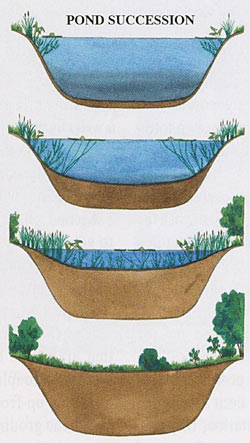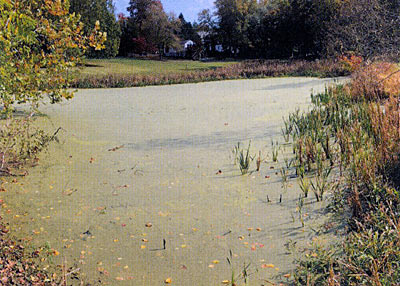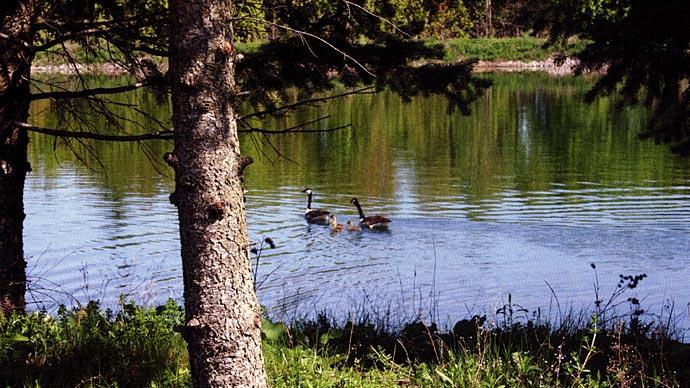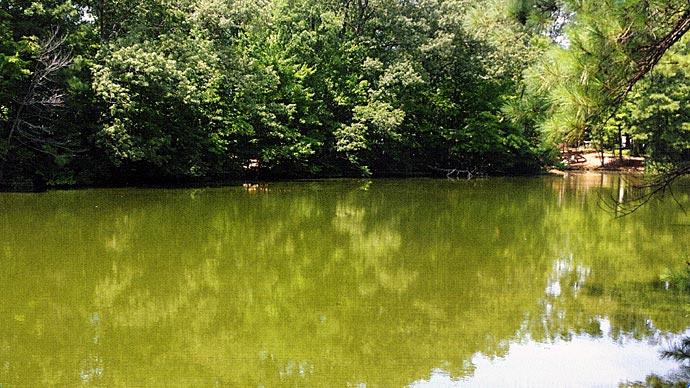
It can be said that "ponds are born to die," because over time, all ponds undergo natural succession. This aging process can vary in time from 25-100 years or more depending on pond location, water depth, size, latitude, longitude, watershed range of elevation, runoff velocity, soil types, rates of sedimentation, nutrient loads, primary productivity rates, loads of total dissolved and suspended solids, water quality, annual range in water temperatures, sunlight, light penetration (secchi depth), spectral energy, algal and aquatic plant species, growth, distribution and abundance, invasive species, and so on.
Many factors lead to natural succession.
Prior to the mid-20th century, a pond was defined as a shallow body of water with sunlight penetrating to the bottom year round and with plants growing across the pond bottom. From a governmental regulatory view point, there is no distinction between a lake and a pond. Both are considered surface freshwaters of the state (U.S.) and subject to the same water quality standards. From a naming convention, there is no precise difference except size and depth between a lake and pond, although waterbodies named lakes are generally larger and/or deeper than those named ponds. In 1968, when I started conducting my doctoral research on a pond located in the Texas A&M University Wildlife Research Area, bodies of water carried more colloquial names. In the previous 100 years or more, small, shallow man- made ponds were called cattle tanks, and primarily provided year around water for livestock.
From an ecology or limnology perspective, there is a difference between the two. The Geographic Names Information System (GNIS), a U.S. government-sponsored database that attempts to standardize naming of geographical features, defines a lake as a "natural body of inland water," but also includes no less than 54 other similar geographical terms—including their definition of a pond. Attempting to get more specific from there raises some semantic problems.
Maybe Pond Boss founding editor, Mark McDonald, got it right. He said, "If it's three acres, and yours, it's a pond. If it's three acres, and mine, it's a lake!"
Most aquatic scientists today consider a pond to be a body of fresh water less than 10 acres in size, and anything over 10 acres would be considered a lake (according to the U.S. Army Corps of Engineers definition).
Regardless of its size, all ponds and lakes go through a natural process called succession. Succession can result from both naturally occurring processes or from pollution, which is defined as "human alteration of the environment." For the purposes of this article, only naturally-caused succession will be discussed.
The color illustration shows a pond undergoing succession from a pond to a bog, grassland, and forest.
Ponds and lakes trap sediment and play a significant role in preventing eroded materials from being transported downstream and deposited in creeks, streams, rivers, and estuaries.
After a pond is built, whether by man (excavation), animals (beavers), or geological processes, the natural physical, chemical, and biological processes begin pond succession. Plant succession and sedimentation begin the process, followed by eutrophication. Together, these processes work slowly over the years and are hardly noticeable or measureable.
The photograph below is of the upper end of a Virginia pond in which new home construction in the upstream watershed has almost filled in the upper Vi of the pond. The bulk of this sedimentation is material flushed out by a 100-year storm (2 yr. ago), depositing silt, sand, gravel, and rocks from the streambed into the upper end of the pond.
Aquatic plants and seeds can be introduced by several mechanisms—water, wind, birds, animals, storm runoff, and even humans (carried in mud on boots, clothing, and boat bottoms). Succession begins when eroded materials from the pond's watershed and organic matter produced in the pond decompose and accumulate on the pond bottom.

Succession can be accelerated by increased sedimentation in surface water runoff from new construction, and erosion. Plus, addition of nutrients washed in from over-fertilized yards, farms, pastures, and Home Boys—resident geese, especially those geese that live on a pond year-round (See: Champ. Pond Boss, 2011, Jan/ Feb and March/April). Even autumn tree leaves carried into a pond by runoff or wind can speed things up. It can be defined as the "build-up of rapidly cycled carbon" (Champ, 1975), because one of the results of rapidly cycled organic carbon is the removal of oxygen from the water column, resulting in oxygen depletion (anaerobic conditions) and fish kills if the Dissolved Oxygen falls below 4.0 mg/1.
Every winter, aquatic plants die or go dormant, sink into the pond, and decay, eventually forming a deep layer of smelly, black, organic muck.
Sunlight in shallow water stimulates photosynthesis and the germination of seeds or roots. Sunlight penetrates the water, and over time, plants grow into a pond, creating an evolving, and dynamic aquatic habitat for all kinds of species—fish, invertebrates, and insects—and develop complex food webs. This is where the issue of water transparency comes into play.
Transparency is a measure of the depth that light penetrates water. Transmission of light is important since the sun is the primary source of energy for photosynthesis. As light penetrates water, it becomes attenuated and altered in its spectral distribution and level of energy. Spectral distribution changes with water depth, from predominantly yellow wave lengths at the surface to blue-green in clear, deep water, yellow- green in waters having a high concentration of dissolved organic material, or very limited light penetration in highly turbid (brown water). This affects the distribution of plant growth.
As emergent, rooted aquatic plants (like cattails with their shallow rhizome root systems) die off each winter, and decompose over a period of 2-3 years, nutrients accumulate. Cattails, over time, grow outward from shallow shoreline edges toward deeper water, encapsulating the pond and trapping sediment, along with organic matter.
From an ecological perspective, thick stands of cattails provide habitat (cover) for many animals that live and hide among them. Red-winged Blackbirds are probably the animal most associated with cattails. Blackbirds are often seen perching and building their nests in them. Mallards and Canada Geese can nest among cattails. Frogs and salamanders will lay their eggs in the water on and between them. Small fish will hide or nest among cattails. While all these facts seem good, the problem with eutrophication is everything is in excess, not moderation—and the pond's diversity, distribution, and abundance of species is decimated. An aging pond becomes more of a monoculture of algae, cattails, spirulina, duckweed, and watermeal. Species diversity drops to one digit, as other plants and fish die off. If a pond owner wants some cattails in a confined area, I recommend raking plants and roots to keep distribution and abundance to small, selected, confined areas. Also, during the first week in September, clip cattail seed heads and bag them in black plastic garbage bags for disposal.
Eutrophic ponds tend to have floating Spirulina and other species of algae due to high levels of nitrogen and phosphorus from years of decomposed organic matter and nutrient input. If water flow circulation in the pond is reduced or blocked by shoreline cattails, the water becomes stagnant, yielding to the next faster growing plants in succession—duckweed and watermeal. These floating plants reproduce exponentially, and dominate the system. Watermeal is the smallest aquatic plant on earth, and the hardest and most expensive to eradicate (easily $1,500/ acre during a pond season in much of the nation). In good sunlight, watermeal can undergo cell division every four hours (exponentially), creating millions of plants in weeks, and completely cover a small pond.

While dredging muck and eroded sedimentation from a pond seems expensive, considering the real estate return on investment, especially in urban areas, it may be a good investment. If the water level is lowered (or during droughts) and muck is removed in small loads, mixed with existing topsoil, and worked to aerate and dry out in a storage area away from the pond, it could make good sense.
Eutrophication is a long-term problem; correcting it involves lowering levels of nutrients— nitrogen and phosphorus—in the pond. Adding aeration technologies to the pond (either by wind, solar, or electric) can reduce eutrophication by removing ammonia (NH4) and other nitrogen gasses, plus H2S (Hydrogen sulfide), which can reverse and/or buy survival time for the pond.
Another method of nutrient reduction is nutrient binding. Binding nutrients involves specifically targeting phosphorus with a binding agent known as aluminum sulfate (or alum) to lower the ratio of P to N, making P the limiting nutrient for plant growth. The addition of aluminum salts (alum) has been used as such for over 35 years to reduce Phosphate levels in waste treatment.
One difficult to control source of nutrient overload are migratory and resident geese, which are protected by Federal law. The resident geese are those that never migrate and live on the pond year around. They lay their eggs, and as the population expands, all those geese can overload the nutrients in a pond very quickly—a single goose can poop two pounds per day. The Hamilton Pond originally had over 100 permanent resident geese, now the resident population is less than five pair of geese, which the pond can handle. Currently, goose eggs are addled (March-April) to prevent migratory geese from nesting, which discourages them from becoming permanent residents. The pond also utilizes two Away With Geese Lights (www.awaywithgeese.com). The continuously flashing light disrupts the guarding behavior of the matriarch goose, and as a result, she will move the flock (Champ, 2011. Pond Boss. Part I (Jan/ Feb). Part II (March/April).
Ponds and lakes are going to age. Succession and eutrophication are natural parts of the process, but both can be delayed and controlled through thoughtful management of water quality, nutrient load, aquatic plant growth, and wildlife control.
References Cited:
Champ. 1975. Current status of nutrient loading in the nation's estuaries. Estuarine Pollution Control and Assessment Conference. Vol. 1. U.S. EPA Office of Water Planning and Standards. Washington, DC.
Champ. 1983. Jour, of Fisheries and Aquatic Science. 40(Suppl. 2):5-8.
Stephen Forbes, "The Lake as Microcosm." Bulletin of the Scientific Association (Peoria, IL), 1887: pp. 77-87.
Dr. Michael A. Champ has studied the physical, chemical and biological properties of water and their ecological significance in ponds, lakes, rivers, estuaries and oceans for over five decades in academia, government, and industry, drmikechamp@gmail.com, (703) 946-6655.
Reprinted with permission from Pond Boss Magazine



